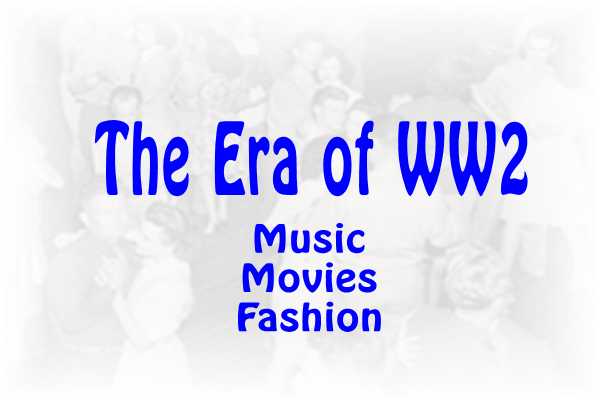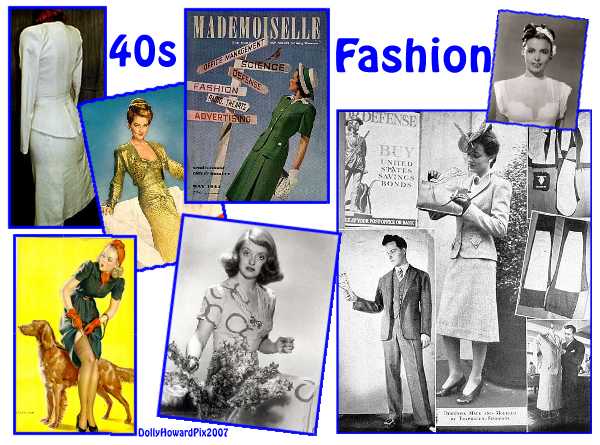
LADIES FASHIONS OF THE
NINETEEN-HUNDRED FORTIES
Written by Carol Nolan
It is worthless to discuss fashion of the forties without first understanding the tremendous impact World War II had on everyday life during the early part of the decade. Social trends dictate fashion. World War II changed the world of fashion forever.
On September 3, 1939 England and France declared war on Germany for invading Poland, and refusing to withdraw troops. On June 14, 1940 Paris fell to Germany. German occupation began controlling haute couture. During the war, the Germans seriously considered moving the French couture houses to Berlin and re-establishing the seat of haute couture in Berlin. Berlin would then be known as the fashion capital of the world. On September 3, 1940, the United States transferred destroyers to Great Britain. The United States officially entered World War II on December 8, 1941.
Prior to World War II, New York fashion designers made the trek across the Atlantic Ocean to attend the flamboyant and opulent French fashion shows each year. They then returned to the United States and copied the latest Parisian haute couture designs. Once the Germans occupied Paris and the United States stationed battleships in the Atlantic Ocean, the New York designers were cut off from Paris haute couture. In their attempts to design new fashions for the United States market, they concentrated on sportswear. This led to the United States emerging as the sportswear capital of the world.
In 1941, war good manufacturing took center stage. The government confiscated all stock of natural fabrics, forcing domestic manufacturers to concentrate on substituting other fibers for domestic garments. The industry geared up rayon production. Nylon stockings disappeared in 1943.
During 1942, the War Production Board began severely restricting the amount of yardage used in garments. On March 8, 1942 the War Production Board issued regulation L - 85, which regulated every aspect of clothing. Stanley Marcus was the apparel consultant to the War Production Board. At this time he took the stand that it was the designerdz patriotic duty to design fashions which would remain stylish through multiple seasons.
In an effort to comply with the restrictions outlined in the regulation, American designers created a new style of suits for women. Skirts were short and straight topped by short jackets of twenty-five inches or less in length. Cardigans matched skirts and sheath evening dresses replaced the long flowing gowns of the thirties.
McCalls produced patterns for transforming mendz suits into ladiesǍ suits and womendz dresses into children clothing. The women of America were once again sewing their own and their family garments.
While the decade of the thirties saw the theme of thrift in purchasing garments, the theme of the forties was a conservative look which would remain fashionable through multiple seasons. Women magazines were abundant with articles on proper care of garments for maximum wear.
American designers introduced the concept of separates and coordinating components in order to create the illusion of more outfits than one actually had. Classic sportswear styles took hold on college campuses and were soon adopted by all levels of society and all age groups.
August 25, 1944 finally saw the end of the German occupation of Paris. In order to re-establish Paris Ǡdomination of the world of fashion, fifty-three French couturiers banded together in 1945 to create a traveling exhibition, known as 씨éâtre de la Modenbsp; Participating designers included Cristóbal Balenciaga, Jacques Fath, Jean Patou, Elsa Schiaparelli and Robert Ricci, son of Nina Ricci.
The exhibition, consisting of dolls positioned in fully furnished sets, derived an eighteenth century method of presenting fashion to the world by means of dressed dolls. The dolls in the Théâtre de la Mode were dressed by the couturiers, artisans and textile workers while artists and theater people joined forces to create the sets the dolls were placed in for viewing. Miniature accessories were created for the dolls including hats, shoes, handbags, gloves, belts and umbrellas. Elegant wigs of human hair were created for the dolls by top hairdressers. Cartier and Van Cleef & Arpels also joined the effort by creating miniature, to-scale jewelry for the dolls. The dolls were completely dressed including lingerie.
The Théâtre de la Mode also helped raise money for the French War Relief. It opened at the Louvre in Paris and then traveled to Barcelona, London, Leeds, Copenhagen, Stockholm, Vienna, New York and San Francisco.
The little dolls accomplished the task they were sent into the world to do. In 1946, Paris regained its title as seat of fashion.
After the war, the American woman was ready for a change, tired of the severely tailored garments she was forced to wear during the hostilities. In 1947, Dior introduced the new look with longer lengths and fuller skirts. The use of many yards of fabric in garments was now seen as lavish and opulent. Woman's fashion now changed to a soft, feminine and romantic image.
Many varieties of peplums were in vogue: butterfly, bustle and gathered peplums were a few. Ruffles found their way to skirt hems, necklines and waists. Gored, gathered and A-line skirts were topped with soft, feminine blouses. Blouses donned bows at the center-front neckline and might sport full or puffy sleeves. Collars were cut generously full, in peter pan and traditional pointed shirt-collar designs. Lace also accentuated blouses around the neckline.
Undergarments at the end of the forties had finally made the transition to two separate pieces, the bra and the girdle. The term bras now widely used to identify the upper portion of the outdated corset. After World War II, wire was introduced into bras and nylon stockings came back on the market.
Leather platform shoes were the rage. Their soles were often studded with "nailheads", another sign of opulence and luxury after the severe metal rationing of previous years. The nailhead studding carried over to ladies leather handbags.
While Paris regained its grasp of haute couture after World War II, American designers were gaining momentum, credibility and respect in the area of sportswear.
Woman’s Fashions – 1940s
1940s Fashion – Progressive Chart
1940s Sewing Patterns
40s Clothing on Ebay

|
|
|
|
|
|